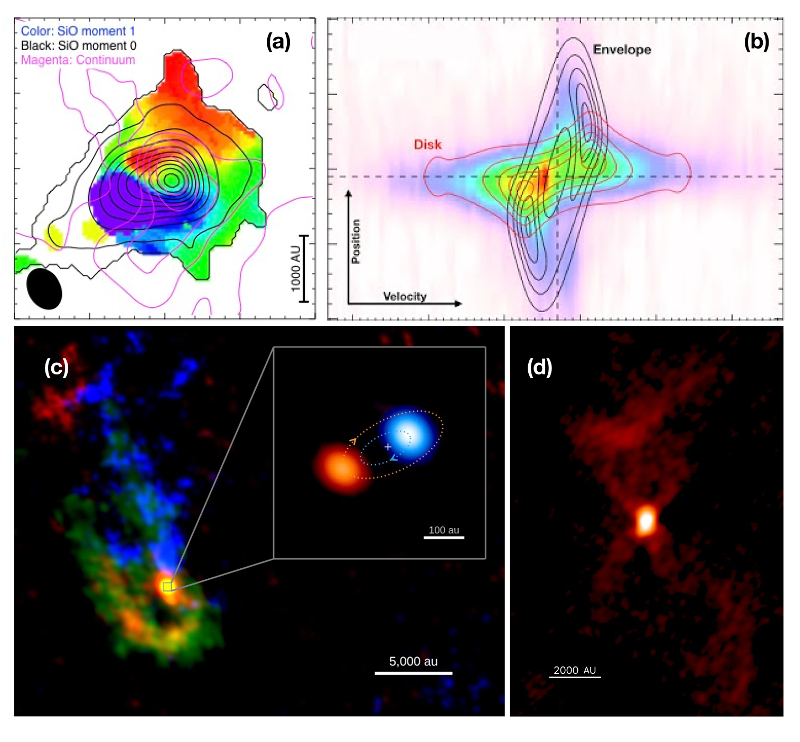| EPoS Contribution |
|
ALMA View of the Innermost Regions of Massive Star Formation
Yichen Zhang RIKEN, Wakoshi, JP | |
| Recent ALMA high-resolution observations start to reveal accretion and feedback processes in massive star formation with great details, including disk formation, binary formation, outflow launching, and photoionization feedback. For example, in the massive protostellar source G339.88-1.26, our observation revealed a highly collimated SiO jet. Rotational features perpendicular to this jet are detected in various molecular lines with different kinematics. In particular, the disk is traced by the SiO emission (Fig. a and b), while other typical hot core molecules only trace the envelope or disk-envelope transition. These results show an ordered transition from an infalling-rotating envelope to a Keplerian disk in massive star formation similar to low-mass cases. In IRAS 07299-1651, the observation revealed a forming massive binary with an apparent separation of 180 au (Fig. c). Both protostars are associated with HRL emissions, and have a line-of-sight velocity difference of ∼10 km/s, which can be explained by binary orbital motions and used to constrain binary properties. Furthermore, the HRL kinematics suggest a rotating circumstellar disk of 10 au radius around the primary. At the same time, there are large-scale gas streams from ∼10,000 au down to ∼1000 au from the center, with kinematics consistent with rotating infall. The binary system, with a few hundred au separation, fits perfectly into this multi-scale picture, in which the large-scale streams feed a disk, which has fragmented to form the binary and further feeds the circumstellar disks. Toward G45.47+0.05, the observation revealed a wide-angle bipolar ionized outflow with strong H30alpha maser (Fig. d). The outflow is found to be photoevaporative driven by a 30-50 Msun star. The H30alpha kinematics is dominated by rotation close to the disk plane and accelerated in outflowing motion above the disk plane. There are also hints of a jet embedded in the ionized outflow, suggesting ongoing accretion in spite of the strong photoionization feedback. These results indicate ordered behaviors within 1000 au scale of massive protostars. The results also show the importance of using different tracers, including different molecular and recombination lines, in deciphering the dynamics of the innermost region of massive star formation. | |
 | |
| Caption: Fig. (a): ALMA observation of G339.88-1.26 showed a rotational structure in SiO emission (color: SiO moment 1; black: SiO moment 0; magenta: 1.3mm continuum). Fig. (b): The kinematics of SiO emission can be explained by the Keplerian rotation of a disk (color: data; contours: model). Fig. (c): ALMA observation of IRAS 07299-1651 revealed a close massive binary system in formation (inset panel; 1.3mm continuum) fed by streams of the gas (green: 1.3mm continuum; red/blue: red/blue-shifted CH3OH emissions). Fig. (d): ALMA observation of massive protostar G45.47+0.05 revealed a photoionized bipolar outflow (color: 1.3mm continuum). | |
| Collaborators: K. Tanaka, Osaka, JP J. Tan, Chalmers, SE N. Sakai, RIKEN, JP V. Rosero, NRAO, US J. Buizer, NASA, US M. Liu, Virginia, US M. Beltran, INAF, IT K. Kratter, Arizona, US D. Mardones, UChile, CL G. Garay, UChile, CL |
Key publication
Suggested Session: High-Mass Star Formation |

